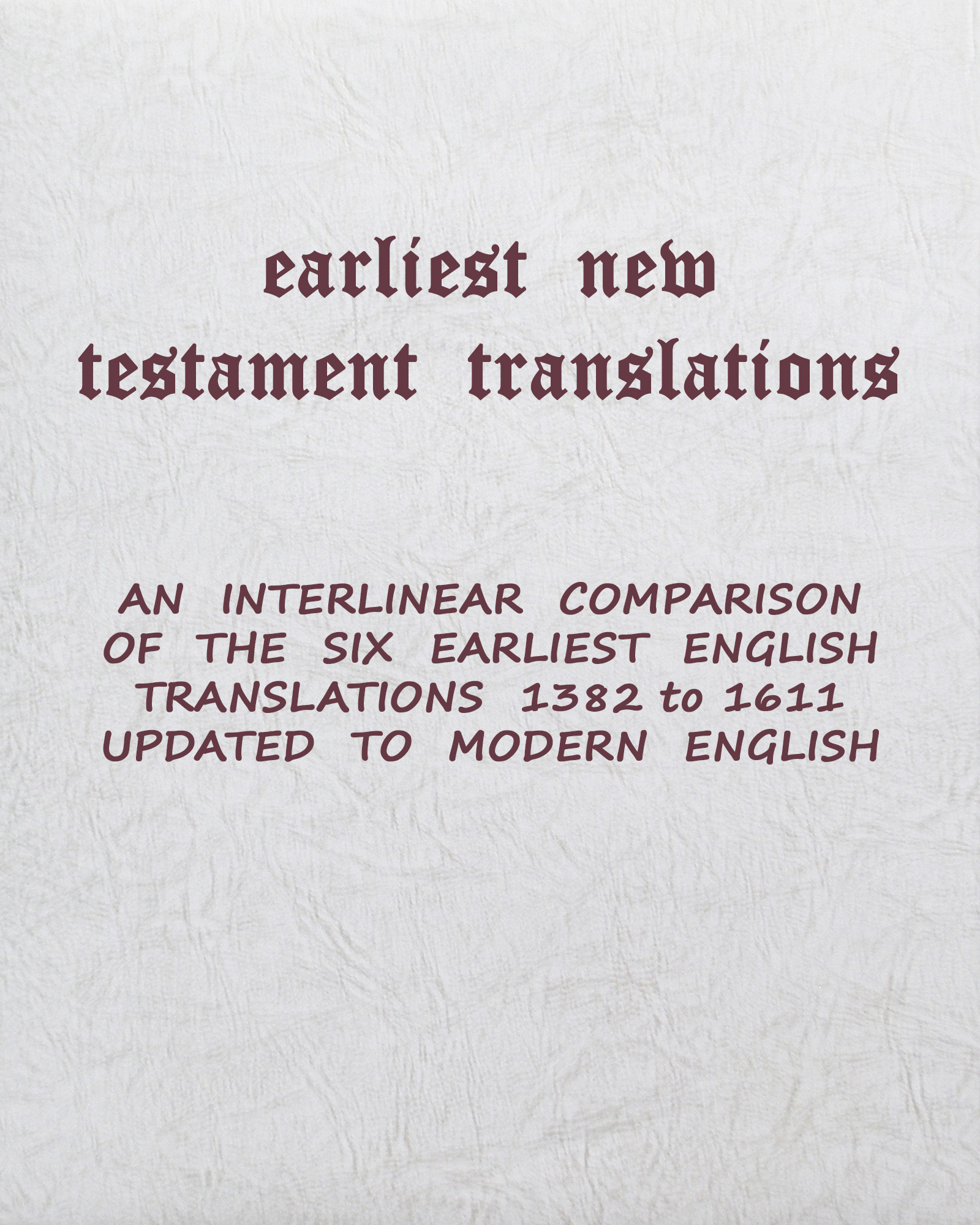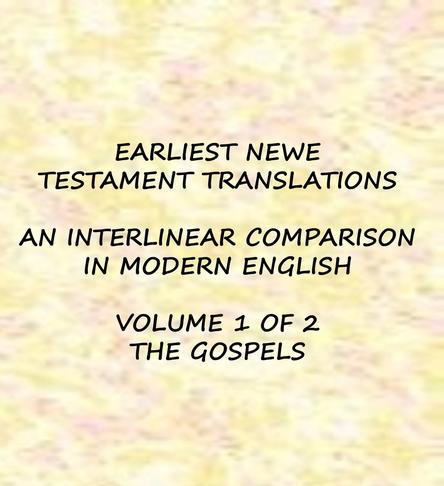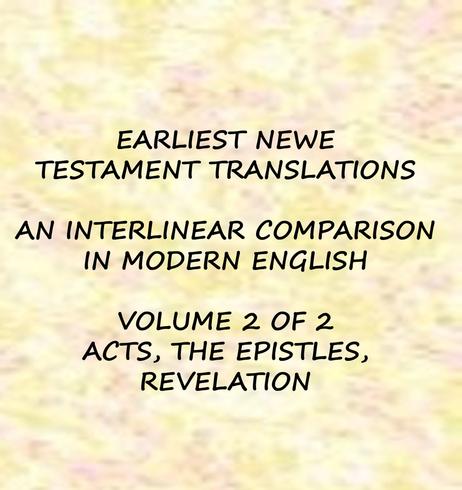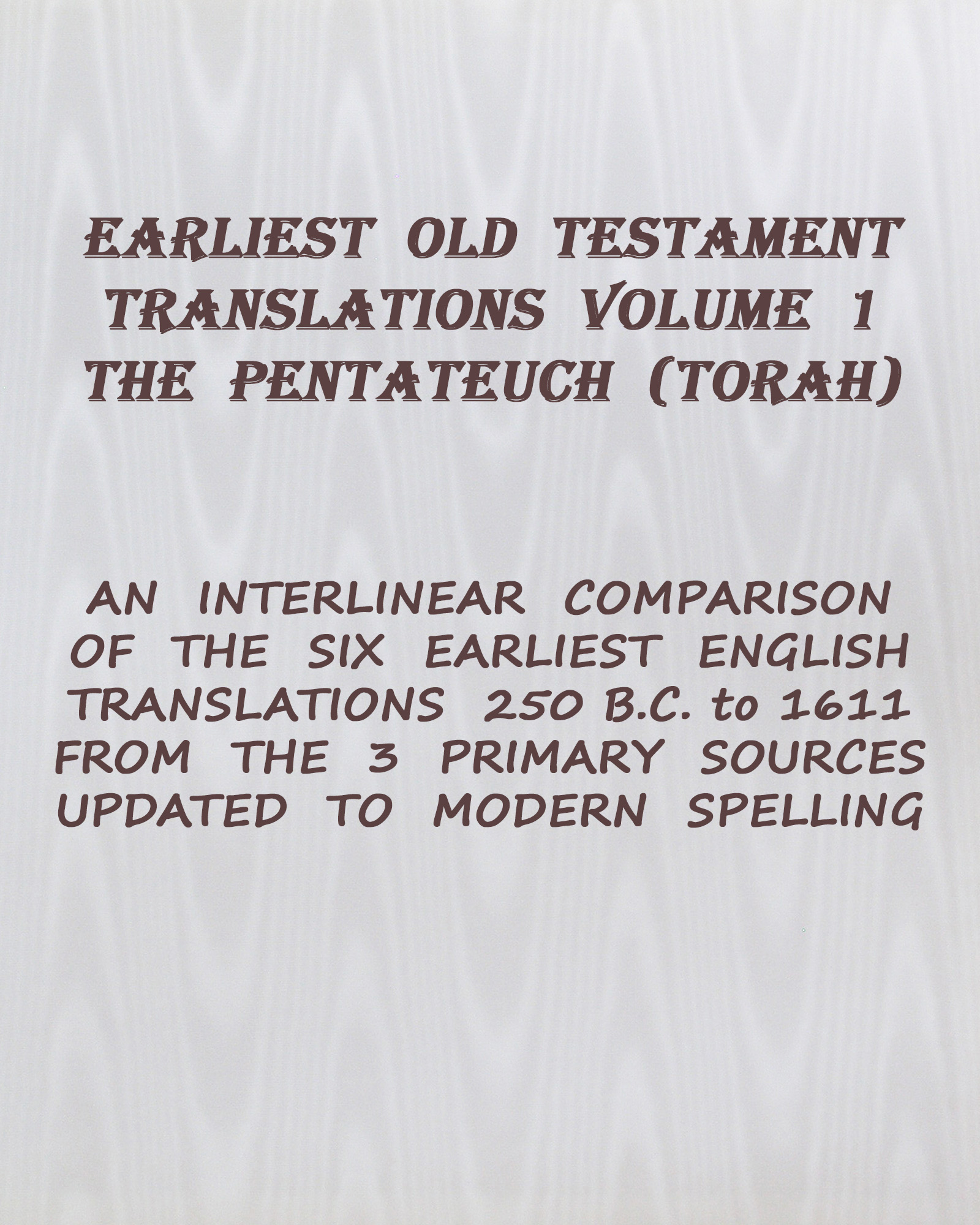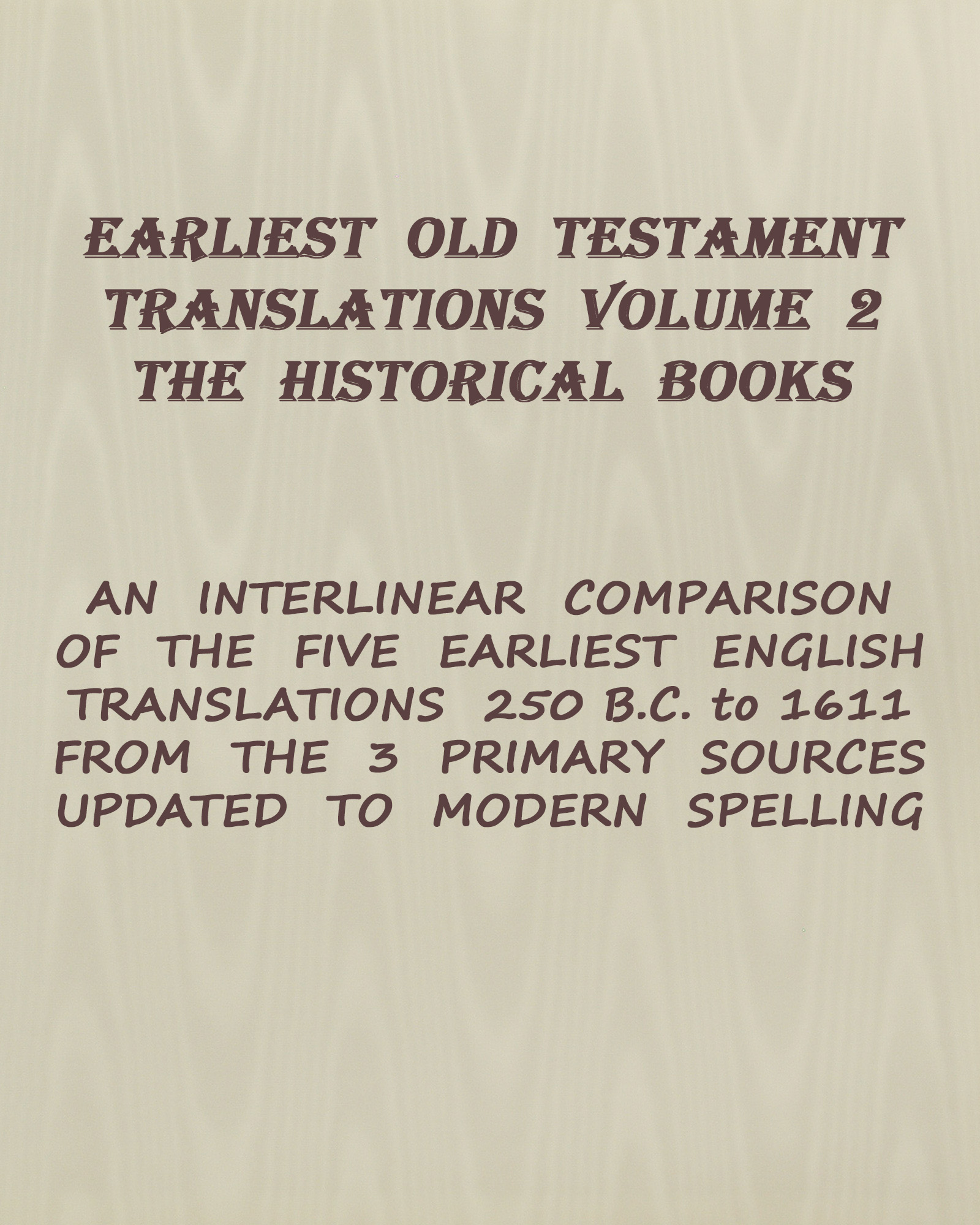Comparisons of Classic Pre-18th Century Bibles
To the best of my knowledge these are the only such comparison studies available anywhere.
Be sure to check back again as more are being added as I complete them.
Earliest New Testament translations: an interlinear comparison in modern English
A comparison of six of the most significant of the reformation and pre-reformation era translations of the New Testament into English for Amazon Kindle readers.
All of the original wording has been retained for accuracy and authenticity, but the big stumbling block of spelling has been eliminated. All of the spelling has been updated to modern standards so that the reader can concentrate on the meaning of the scripture as these early devoted translators translated it instead of the wayward spelling.
The preface to Earliest New Testament Translations begins with a 4 page introduction explaining why these early New Testament translations are still important today, and continues with a brief chronology of the evolution of the Bible in the English language in general, and of the New Testament specifically. Following this are short discussions of the importance and development of the translations selected for this comparison study.
Earliest New Testament Translations continues with each book of the New Testament presented with a brief, one sentence introduction listing the most likely author, date, and his purpose in writing. Chapters in the earlier translations are broken into verses to match the King James Version and each verse is presented in 5 parallel translations.
Chosen for this comparison study were:
1. The New Testament from the John Wycliffe Bible (both early and later versions). This was the first Bible ever translated into the English language. It was translated from the Latin Vulgate. These are presented in separate parallel verses.
2. The William Tyndale New Testament (both 1526 and 1534 versions). This was the first New Testament ever translated into the English language directly from its Koine Greek mother tongue. These were similar enough that I was able to present them in a single verse, with the differences noted.
3. The New Testament from the Geneva Bible. This was the first Bible to break the chapters into individually numbered verses and was the first Bible brought to this country by the pilgrims. It remained the most popular Bible in England for over 100 years after the introduction of the King James Version in 1611.
4. The New Testament from the King James Version. No comparison of Bible translations would be complete without including the venerable King James Version.
Expanded earliest New Testament translations: an interlinear comparison in modern English
Expanded Earliest New Testament Translations is an expansion of the previous "Earliest New Testament Translations". It is a verse-by-verse comparison of 8 of the most important translations of the New Testament into English through the end of the 19th century. All original wording has been retained for accuracy and authenticity, but the big stumbling block of spelling in the original 1611 King James and earlier translations has been eliminated. All of the spelling in these earliest translations has been updated to modern standards so that the reader can concentrate on the meaning of the scripture as these early devoted scholars translated it.
The preface also begins with an introduction explaining why these particular New Testament translations, which are now out of print, are still important today. The preface continues with a brief chronology of the evolution of the Bible in the English language in general, and of the New Testament specifically. Following this are short discussions of the importance and development of the translations selected for this comparison study.
Expanded Earliest New Testament Translations continues with each book of the New Testament presented with a brief introduction from the Rheims New Testament. Chapters in the earliest translations are broken into verses to match the King James and each verse is presented in 8 parallel translations. The translations are organized and identified as to which of the 3 primary sources of scripture (Latin Vulgate; Textus Receptus and Byzantine text type; or Westcott and Hort and the Alexandrian text type) were used for the English translation.
Chosen for this comparison study from Latin Vulgate origin were:
1 & 2. The New Testament from the John Wycliffe Bible (both early and later versions). This was the first Bible ever translated into the English language.
3. The New Testament from the1763 Challoner Revision of the 1609 Douay-Rheims Bible. This remained the standard Catholic New Testament until 1941.
Chosen for this comparison study from Textus Receptus (Byzantine text type) origin were:
1. The William Tyndale New Testament (both 1526 and 1534 versions). This was the first New Testament ever translated into the English language directly from its Koine Greek mother tongue. These were similar enough that I was able to present them in a single verse, with the differences noted.
2. The New Testament from the Geneva Bible. This was the first Bible to break the chapters into individually numbered verses and was the first Bible brought to the new world by the pilgrims. It remained the most popular Bible in England for over 100 years after the introduction of the King James.
3. The New Testament from the King James Version. No comparison of Bible translations would be complete without including the venerable King James Version.
Chosen for this comparison study from Westcott and Hort (Alexandrian text type) origin were:
1. The New Testament from the English Revised Version. This was the first major departure from the Textus Receptus, and marks the start of the trend toward all of the "new" bible translations of today. It was also the first use of the newly completed Westcott and Hort Greek New Testament, which relied mostly on the oldest Greek texts of the Alexandrian text type.
2. The New Testament from the American Standard Version. This was the first American departure from the Textus Receptus, and includes the American inputs to the English Revised Version, which were given only lip service by the British scholars.
Earliest Old Testament translations volume 1: The Pentateuch (Torah) an interlinear comparison in modern English
Earliest Old Testament Translations Volume 1 is a comparison of 6 of the most important of the reformation and pre-reformation translations of the Old Testament Pentateuch into English. All of the original wording has been retained for accuracy and authenticity, but the big stumbling block of spelling has been eliminated. All of the spelling has been updated to modern standards so that the reader can concentrate on the meaning of the scripture as these early devoted translators translated it instead of stumbling over the wayward spelling.
The preface to Earliest Old Testament Translations Volume 1 begins with a short introduction explaining why these early Old Testament translations are still important today, and continues with a brief chronology of the significant milestones in the evolution of the Bible in the English language. Following this are short discussions of the importance and development of the translations selected for this comparison study.
Earliest Old Testament Translations Volume 1 continues with each of the first five books of the Old Testament presented with a brief, one sentence summary of the content. Chapters in the earlier translations are broken into verses to match the King James and each verse is presented in 6 parallel translations. is also included discussing the use of the singular vs. plural nouns and pronouns used for God in Genesis Chapter 1, the massive number of people in the exodus, and the mistranslation of Red Sea in Exodus chapter 13.
Chosen for this comparison study were:
1. The Old Testament Pentateuch from the third century B.C. Greek Septuagint as translated into English in 1851. The Greek Septuagint is the earliest known translation of the Hebrew scriptures into any other language.
2. The Old Testament Pentateuch from the John Wycliffe Bible of 1395. This was the first complete Bible ever translated into the English language. It was translated from St. Jerome’s early fifth century Latin Vulgate and was the foundation for the later reformation.
3. The Old Testament Pentateuch from the Douay Old Testament as revised by Bishop Richard Challoner in 1763. The Douay Old Testament first completed in 1610 and it’s subsequent revisions have remained the Old Testament for Catholic bibles to this day. This as well was a translation of St. Jerome’s Latin Vulgate.
4. The William Tyndale Pentateuch of 1530. This was the first translation of any portion of the Old Testament into the English language directly from the Hebrew Masoretic text.
5. The Old Testament Pentateuch from the Geneva Bible of 1560. This was the first Bible to break the chapters into individually numbered verses and was the first Bible brought to this country by the pilgrims. It remained the most popular Bible in England for over 100 years after the introduction of the King James.
6. The Old Testament Pentateuch from the King James Version of 1611. No comparison of Bible translations would be complete without including the venerable King James Version.
Earliest Old Testament translations volume 2: the historical books an interlinear comparison in modern English
Earliest Old Testament Translations Volume 2 is a comparison of 5 of the most important of the reformation and pre-reformation translations of the Old Testament historical books (Joshua, Judges, Ruth, Samuel (2), Kings (2), Chronicles (2), Ezra, Nehemiah, Esther) into English. All of the original wording has been retained for accuracy and authenticity, but the big stumbling block of spelling has been eliminated. All of the spelling has been updated to modern standards so that the reader can concentrate on the meaning of the scripture as these early devoted translators translated it instead of stumbling over the wayward spelling.
The preface to Earliest Old Testament Translations Volume 2 begins with a short introduction explaining why these early Old Testament translations are still important today, and continues with a brief chronology of the significant milestones in the evolution of the Bible in the English language. Following this are short discussions of the importance and development of the translations selected for this comparison study.
Earliest Old Testament Translations Volume 2 continues with each of the historical books of the Old Testament presented with a brief, one sentence summary of the content. Chapters in the earlier translations are broken into verses to match the King James and each verse is presented in 5 parallel translations.
Chosen for this comparison study were:
1. The selected Old Testament books from the third century B.C. Greek Septuagint as translated into English in 1851. The Greek Septuagint is the earliest known translation of the Hebrew scriptures into any other language.
2. The selected Old Testament books from the John Wycliffe Bible of 1395. This was the first complete Bible ever translated into the English language. It was translated from St. Jerome’s early fifth century Latin Vulgate and was the foundation for the later reformation.
3. The selected Old Testament books from the Douay Old Testament as revised by Bishop Richard Challoner in 1763. The Douay Old Testament first completed in 1610 and it’s subsequent revisions have remained the Old Testament for Catholic bibles to this day. This as well was a translation of St. Jerome’s Latin Vulgate.
4. The selected Old Testament books from the Geneva Bible of 1560. This was the first Bible to break the chapters into individually numbered verses and was the first Bible brought to this country by the pilgrims. It remained the most popular Bible in England for over 100 years after the introduction of the King James.
5. The selected Old Testament books from the King James Version of 1611. No comparison of Bible translations would be complete without including the venerable King James Version.
